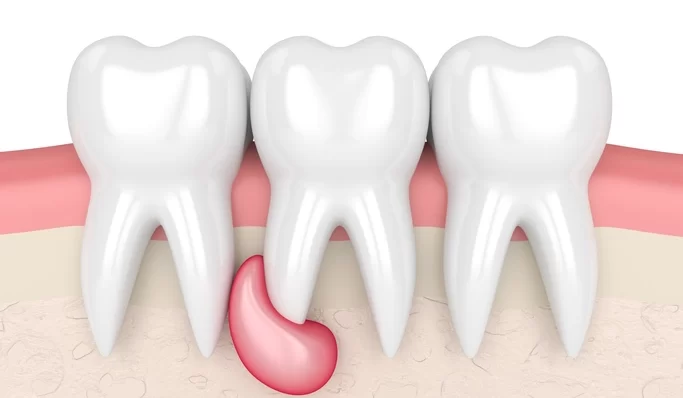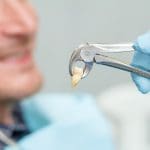Dental cysts are common but potentially serious oral health conditions that can develop in various parts of the mouth. These cysts are sacs filled with fluid, tissue, or other substances and can lead to complications if left untreated. Understanding the types, causes, symptoms, diagnosis, and treatment of dental cysts is essential for proper oral health care.
Types of Dental Cysts
- Radicular Cysts (Periapical Cysts)
- Dentigerous Cysts (Follicular Cysts)
- Odontogenic Keratocysts
- Gingival Cysts
Radicular Cysts (Periapical Cysts)
- Location: Develop at the tip of a tooth’s root due to an infection in the tooth pulp.
- Cause: Usually a result of untreated tooth decay or trauma that allows bacteria to enter the pulp.
Dentigerous Cysts (Follicular Cysts)
- Location: Around the crown of an unerupted or partially erupted tooth.
- Cause: Develop from the accumulation of fluid between the enamel and dental follicle.
Odontogenic Keratocysts
- Location: Often found in the jawbone and can grow to a large size.
- Cause: Believed to stem from the remnants of dental tissue development.
Gingival Cysts
- Location: On the gums, usually in infants.
- Cause: Often arise during the development of the mouth and typically harmless.
Causes of Dental Cysts
The primary cause of dental cysts is usually associated with infections, developmental issues, or other factors affecting the teeth or surrounding tissues. Poor oral hygiene, untreated tooth decay, or trauma to the teeth can lead to cyst formation. Additionally, genetic predispositions or abnormalities in dental development can contribute to cyst growth.
Symptoms of Dental Cysts
Dental cysts might not always show obvious symptoms in the early stages. However, as they grow, some common signs and symptoms may include:
- Swelling in the gums, face, or neck
- Pain or tenderness in the affected area
- Difficulty in chewing or biting
- Sensitivity to hot or cold
- Discharge of pus or blood from the affected area
- Shifting of adjacent teeth or changes in bite alignment
Diagnosis of Dental Cysts
A dentist or oral surgeon can diagnose a dental cyst through various methods, including:
- Clinical Examination: Checking for signs of swelling, tenderness, or other visible symptoms.
- X-rays: Identifying cysts and their location within the jawbone or near the affected tooth.
- Biopsy: Extracting a small tissue sample for laboratory analysis to confirm the nature of the cyst.
Treatment of Dental Cysts
The treatment for dental cysts usually involves surgical intervention and may vary depending on the type, size, and location of the cyst. Common treatment options include:
- Cyst Removal
- Root Canal Treatment
- Medication
- Monitoring
Cyst Removal
Surgical excision of the cyst, often done under local anesthesia.
Root Canal Treatment
For cysts associated with infected tooth pulp, a root canal procedure may be necessary.
Medication
Antibiotics or other medications might be prescribed to manage infections or prevent recurrence.
Monitoring
Regular follow-ups with the dentist to monitor healing and prevent complications.
Complications and Prevention
If left untreated, dental cysts can lead to serious complications, including damage to surrounding teeth, jawbone deterioration, and in rare cases, the potential for malignant transformation. To prevent dental cysts, maintaining good oral hygiene, regular dental check-ups, timely treatment of dental issues, and avoiding dental trauma are essential.
Management and Prognosis
The management of dental cysts involves a multidisciplinary approach, often requiring the expertise of dentists, oral surgeons, and sometimes, maxillofacial specialists. The prognosis for dental cysts is generally favorable with early detection and appropriate treatment. However, the specific prognosis depends on various factors, including the type, size, and location of the cyst, as well as the patient’s overall oral health.
Surgical Intervention
- Cyst Removal Surgery
- Marsupialization
Cyst Removal Surgery
The primary treatment for most dental cysts involves surgical removal. This procedure, performed under local or general anesthesia, aims to completely excise the cyst while preserving surrounding healthy tissue. Depending on the size and complexity, this surgery may be straightforward or more intricate, requiring careful planning and skillful execution.
Marsupialization
In cases where the cyst is exceptionally large or complex, marsupialization might be considered. This technique involves creating an opening in the cyst and allowing it to drain gradually. Over time, this helps reduce the size of the cyst, making subsequent surgical removal easier.
Postoperative Care
Following cyst removal or marsupialization, postoperative care is crucial for optimal healing and to prevent complications. Patients may be advised to:
- Take prescribed medications, including antibiotics or pain relievers, as directed by their dentist or oral surgeon.
- Maintain good oral hygiene through gentle brushing and rinsing with a prescribed mouthwash.
- Follow a soft or liquid diet for a few days to avoid putting pressure on the surgical site.
- Attend scheduled follow-up appointments for evaluation and removal of any sutures.
Recurrence and Follow-up
Although proper treatment usually resolves dental cysts, there’s a slight risk of recurrence, especially if the cyst was not entirely removed or due to underlying factors. Regular follow-up visits with the dentist or oral surgeon are essential to monitor the healing process and detect any signs of recurrence or complications early on.
Research and Advancements
Ongoing research in dentistry aims to enhance diagnostic techniques, improve treatment outcomes, and explore alternative approaches for managing dental cysts. Advancements in imaging technology, such as cone-beam computed tomography (CBCT), contribute to more accurate diagnosis and precise treatment planning.
Additionally, emerging therapies, including regenerative techniques using growth factors or stem cells, hold promise for promoting tissue regeneration and reducing the likelihood of cyst recurrence in the future.
Patient Education and Awareness
Educating patients about oral health, including the importance of regular dental check-ups, maintaining proper oral hygiene, and seeking timely treatment for dental issues, plays a vital role in preventing dental cysts and other oral conditions. Increased awareness empowers individuals to recognize potential signs and seek professional help promptly, contributing to better oral health outcomes.
Conclusion
Dental cysts are a common oral health concern that, if left untreated, can lead to severe complications. Recognizing the symptoms, seeking timely diagnosis, and appropriate treatment are crucial for managing dental cysts effectively. Regular dental visits, practicing good oral hygiene, and addressing dental problems promptly can significantly reduce the risk of developing these cysts and help maintain optimal oral health. If you suspect any signs of a dental cyst, it’s essential to consult a dental professional promptly for proper evaluation and treatment.






Kelsie Langosh
12 January 2024Its like you read my mind You appear to know so much about this like you wrote the book in it or something I think that you can do with a few pics to drive the message home a little bit but other than that this is fantastic blog A great read Ill certainly be back